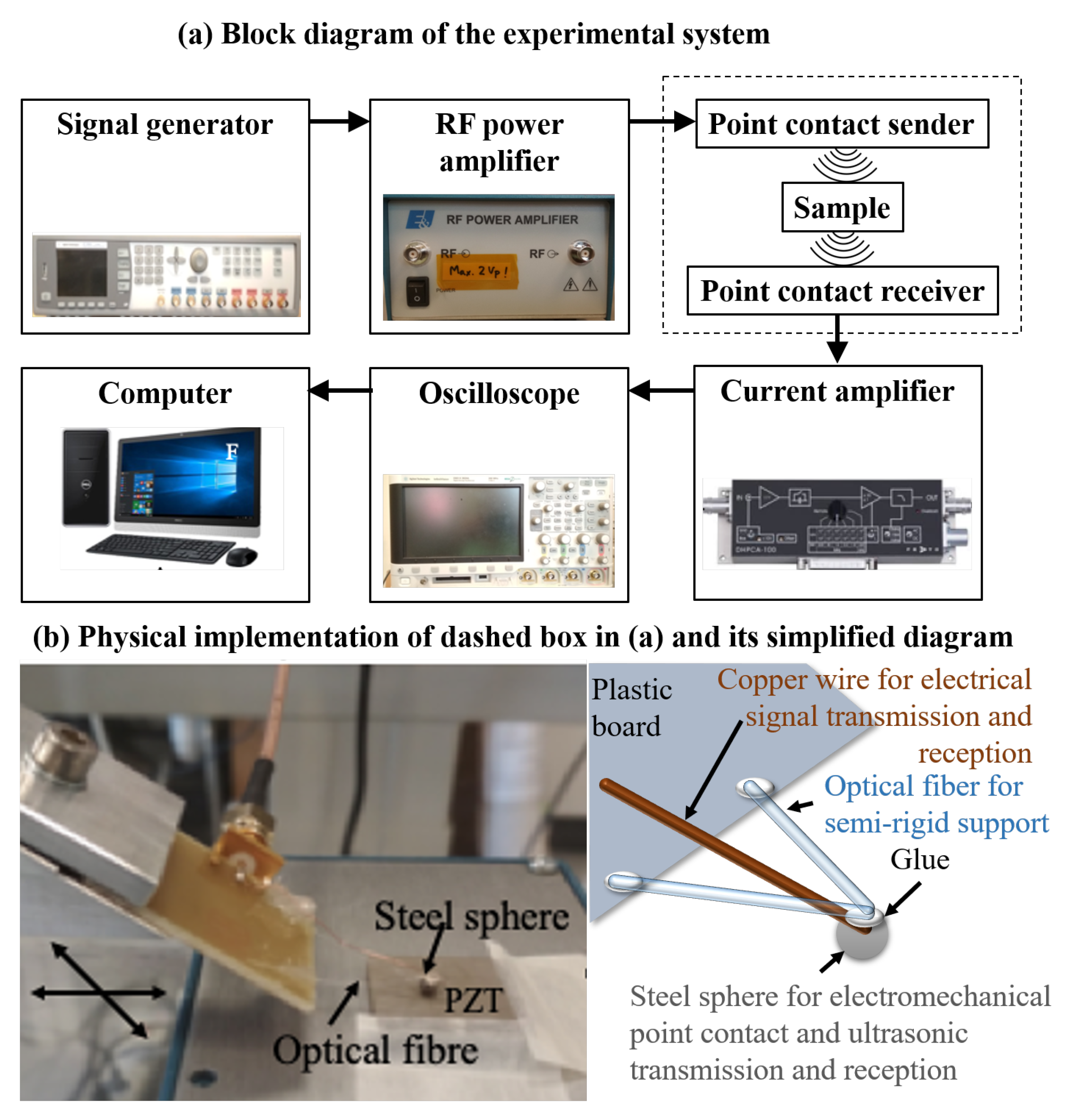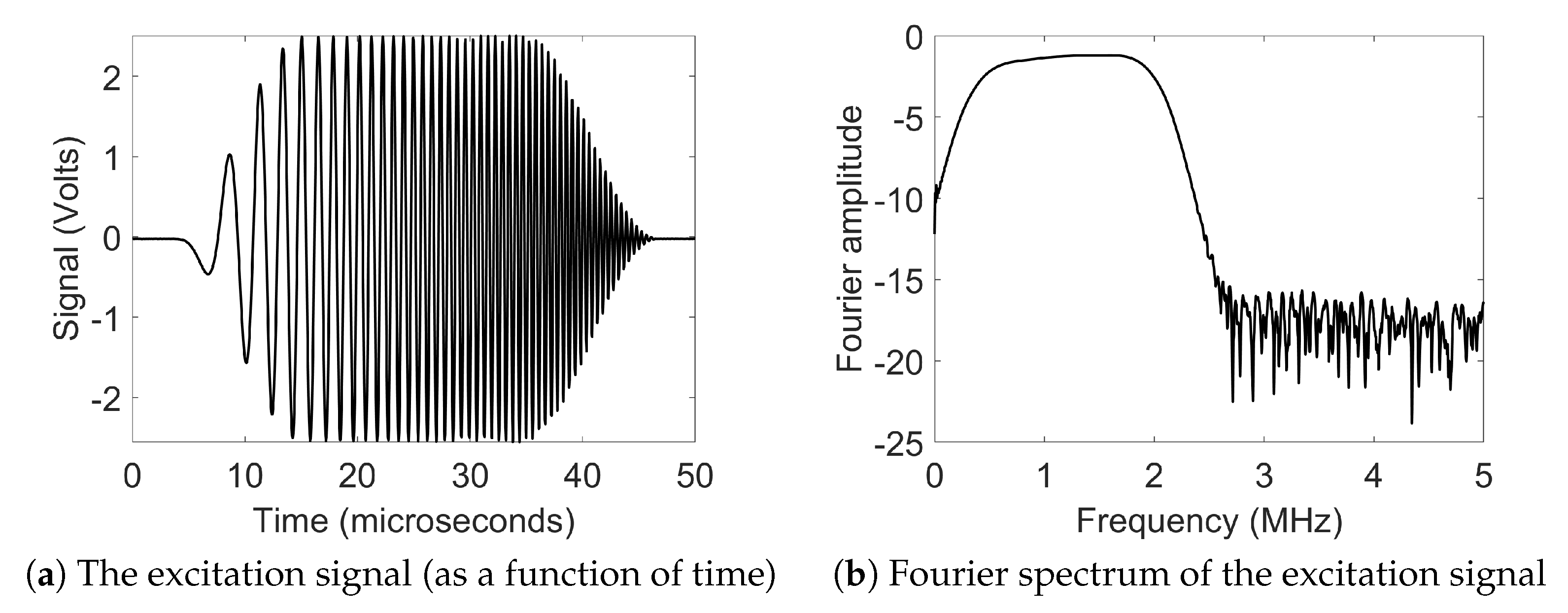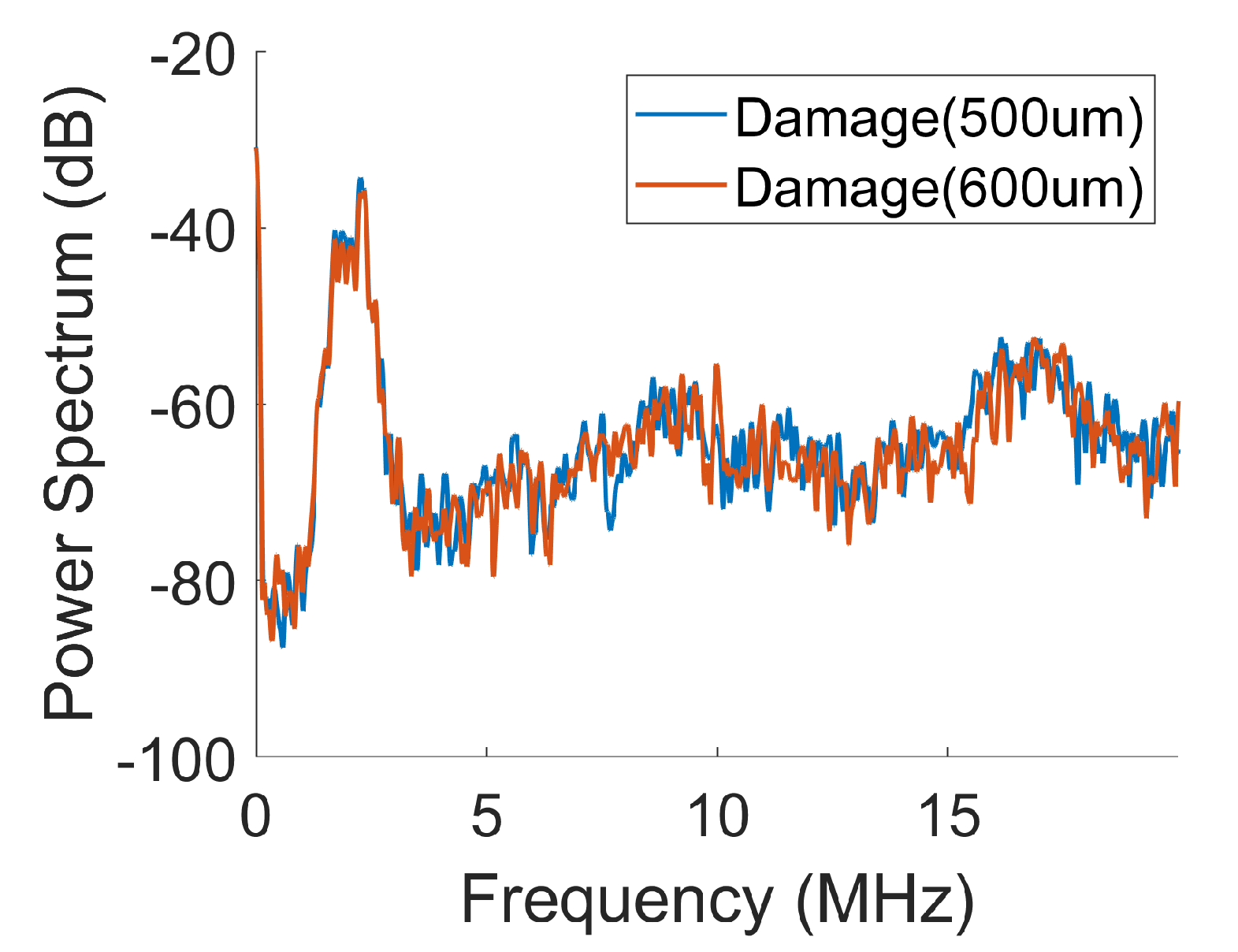Classification of Micro-Damage in Piezoelectric Ceramics Using Machine Learning of Ultrasound Signals
Abstract
:1. Introduction
2. Related Work
3. Experimental Technique
3.1. Point Contact Sensor Fabrication
3.2. PZT Sample Preparation and Damage Creation
3.3. Experimental Set-Up
4. Feature Extraction and Machine Learning Techniques
4.1. Machine Learning Techniques
4.2. Feature Types
- Raw temporal signal—all the 3400 time points in the measurements were used as a single feature vector. For brevity in results, we refer to it as ‘Signal’.
- Discrete cosine transform (DCT) [43]—we compute the DCT of the signal up to the same order as the input raw signal and retained 18.6% of DCT coefficients as the feature vector.
- Power spectral density (PSD)—The real valued power in each Fourier component of the Fourier transform signal resulted in the PSD of the signal and was used as a feature vector. The Fourier transform of the raw signal was computed with the number of Fourier components equal to the number of samples in time domain.
5. Benchmarking of the Feature Types and Learning Approaches
5.1. Experiment 1: Healthy Versus Damaged Samples (500 m)
5.2. Experiment 2: Damaged Samples of Diameters 500 m and 600 m
5.3. Experiment 3: Damaged Samples of Diameters 800 m and 900 m
- Naive Bayes, CNN, and BLSTM architectures are not suited for this classification problem with small difference in the diameters of the damages
- PSD is an important feature type for this classification problem.
6. Hybrid Feature Designs for Improvement in Classification
- PSD + Signal: This hybrid approach is motivated by using the temporal, as well as frequency domain, features together for classification.
- PSD + Signal + sign of slope change (SSC): Sign of slope change is an alternate way of extracting changes in temporal patterns. It was used in [46] for analyzing vibration signal. Here, we include this with the motivation of including the effect of changes in temporal patterns.
- PSD + SSC: The motivation of this hybrid feature is that it is possible that the changes in temporal pattern provide a better differentiation than the temporal signal directly.
7. Discussion
8. Conclusions
Author Contributions
Conflicts of Interest
References
- Klima, S.J.; Baaklini, G.Y.; Abel, P.B. Nondestructive Evaluation of Structural Ceramics; NASA Technical Memorandum 88978; 1987. Available online: https://ntrs.nasa.gov/archive/nasa/casi.ntrs.nasa.gov/19870008676.pdf (accessed on 27 September 2019).
- Duncan, M.D.; Bashkansky, M.; Reintjes, J. Subsurface defect detection in materials using optical coherence tomography. Opt. Express 1998, 2, 540–545. [Google Scholar] [CrossRef] [PubMed]
- Bashkansky, M.; Battle, P.R.; Duncan, M.D.; Kahn, M.; Reintjes, J. Subsurface defect detection in ceramics using an optical gated scatter reflectometer. J. Am. Ceram. Soc. 1996, 79, 1397–1400. [Google Scholar] [CrossRef]
- Bashkansky, M.; Duncan, M.; Kahn, M.; Lewis, D.; Reintjes, J. Subsurface defect detection in ceramics by high-speed high-resolution optical coherent tomography. Opt. Lett. 1997, 22, 61–63. [Google Scholar] [CrossRef] [PubMed]
- Wang, Z.; Zhu, W.; Zhu, H.; Miao, J.; Chao, C.; Zhao, C.; Tan, O.K. Fabrication and characterization of piezoelectric micromachined ultrasonic transducers with thick composite PZT films. IEEE Trans. Ultrason. Ferroelectr. Freq. Control 2005, 52, 2289–2297. [Google Scholar] [CrossRef] [PubMed]
- Kromine, A.; Fomitchov, P.; Krishnaswamy, S.; Achenbach, J. Detection of subsurface defects using laser based technique. AIP Conf. Proc. 2001, 557, 1612–1617. [Google Scholar]
- Habib, A.; Shelke, A.; Amjad, U.; Pietsch, U.; Banerjee, S. Nonlocal Damage Mechanics for Quantification of Health for Piezoelectric Sensor. Appl. Sci. 2018, 8, 1683. [Google Scholar] [CrossRef]
- Pamwani, L.; Habib, A.; Melandsø, F.; Ahluwalia, B.; Shelke, A. Single-input and multiple-output surface acoustic wave sensing for damage quantification in piezoelectric sensors. Sensors 2018, 18, 2017. [Google Scholar] [CrossRef] [PubMed]
- Rabe, U.; Amelio, S.; Kopycinska, M.; Hirsekorn, S.; Kempf, M.; Göken, M.; Arnold, W. Imaging and measurement of local mechanical material properties by atomic force acoustic microscopy. Surf. Interface Anal. 2002, 33, 65–70. [Google Scholar] [CrossRef]
- Whatmore, R.; Goddard, P.; Tanner, B.; Clark, G. Direct imaging of travelling Rayleigh waves by stroboscopic X-ray topography. Nature 1982, 299, 44. [Google Scholar] [CrossRef]
- Habib, A.; Twerdowski, E.; von Buttlar, M.; Pluta, M.; Schmachtl, M.; Wannemacher, R.; Grill, W. Acoustic holography of piezoelectric materials by Coulomb excitation. In Health Monitoring and Smart Nondestructive Evaluation of Structural and Biological Systems V; International Society for Optics and Photonics: San Diego, CA, USA, 2006; Volume 6177, p. 61771A. [Google Scholar]
- Habib, A.; Twerdowski, E.; von Buttlar, M.; Wannemacher, R.; Grill, W. The influence of the radius of the electrodes employed in Coulomb excitation of acoustic waves in piezoelectric materials. In Health Monitoring of Structural and Biological Systems 2007; International Society for Optics and Photonics: San Diego, CA, USA, 2007; Volume 6532, p. 653214. [Google Scholar]
- Habib, A.; Shelke, A.; Pluta, M.; Kundu, T.; Pietsch, U.; Grill, W. Imaging of acoustic waves in piezoelectric ceramics by coulomb coupling. Jpn. J. Appl. Phys. 2012, 51, 07GB05. [Google Scholar] [CrossRef]
- Habib, A.; Shelke, A.; Pietsch, U.; Kundu, T.; Grill, W. Determination of the transport properties of ultrasonic waves traveling in piezoelectric crystals by imaging with Coulomb coupling. In Health Monitoring of Structural and Biological Systems 2012; International Society for Optics and Photonics: San Diego, CA, USA, 2012; Volume 8348, p. 834816. [Google Scholar]
- Habib, A.; Amjad, U.; Pluta, M.; Pietsch, U.; Grill, W. Surface acoustic wave generation and detection by Coulomb excitation. In Health Monitoring of Structural and Biological Systems 2010; International Society for Optics and Photonics: San Diego, CA, USA, 2010; Volume 7650, p. 76501T. [Google Scholar]
- Shelke, A.; Habib, A.; Amjad, U.; Pluta, M.; Kundu, T.; Pietsch, U.; Grill, W. Metamorphosis of bulk waves to Lamb waves in anisotropic piezoelectric crystals. In Health Monitoring of Structural and Biological Systems 2011; International Society for Optics and Photonics: San Diego, CA, USA, 2011; Volume 7984, p. 798415. [Google Scholar]
- Habib, A.; Shelke, A.; Pluta, M.; Pietsch, U.; Kundu, T.; Grill, W. Scattering and attenuation of surface acoustic waves and surface skimming longitudinal polarized bulk waves imaged by Coulomb coupling. AIP Conf. Proc. 2012, 1433, 247–250. [Google Scholar]
- Mitra, M.; Gopalakrishnan, S. Guided wave based structural health monitoring: A review. Smart Mater. Struct. 2016, 25, 053001. [Google Scholar] [CrossRef]
- Fuentes, R.; Mineo, C.; Pierce, S.G.; Worden, K.; Cross, E.J. A probabilistic compressive sensing framework with applications to ultrasound signal processing. Mech. Syst. Signal Process. 2019, 117, 383–402. [Google Scholar] [CrossRef]
- Vogl, F.; Friesenbichler, B.; Hüsken, L.; Kramers-de Quervain, I.A.; Taylor, W.R. Can low-frequency guided waves at the tibia paired with machine learning differentiate between healthy and osteopenic/osteoporotic subjects? A pilot study. Ultrasonics 2019, 94, 109–116. [Google Scholar] [CrossRef] [PubMed]
- Cunha, R.; Maciel, R.; Nandi, G.; Daros, M.; Cardoso, J.; Francis, L.; Ramos, V.; Marcelino, R.; Fröhlich, A.; De Araujo, G.M. Applying Non-destructive Testing and Machine Learning to Ceramic Tile Quality Control. In Proceedings of the 2018 VIII Brazilian Symposium on Computing Systems Engineering (SBESC), Salvador, Brazil, 5–8 November 2018; pp. 54–61. [Google Scholar]
- Addin, O.; Sapuan, S.; Mahdi, E.; Othman, M. A Naïve-Bayes classifier for damage detection in engineering materials. Mater. Des. 2007, 28, 2379–2386. [Google Scholar] [CrossRef]
- Kundu, A.; Sikdar, S.; Eaton, M.; Navaratne, R. A Generic Framework for Application of Machine Learning in Acoustic Emission-Based Damage Identification. In Proceedings of the 13th International Conference on Damage Assessment of Structures, Porto, Portugal, 9–10 July 2019; pp. 244–262. [Google Scholar]
- Yan, G. A Bayesian approach for damage localization in plate-like structures using Lamb waves. Smart Mater. Struct. 2013, 22, 035012. [Google Scholar] [CrossRef]
- Cantero-Chinchilla, S.; Chiachío, J.; Chiachío, M.; Chronopoulos, D.; Jones, A. A robust Bayesian methodology for damage localization in plate-like structures using ultrasonic guided-waves. Mech. Syst. Signal Process. 2019, 122, 192–205. [Google Scholar] [CrossRef]
- Gallina, A.; Ambrozinski, L.; Packo, P.; Pieczonka, L.; Uhl, T.; Staszewski, W.J. Bayesian parameter identification of orthotropic composite materials using Lamb waves dispersion curves measurement. J. Vib. Control 2017, 23, 2656–2671. [Google Scholar] [CrossRef]
- Wunderlich, C.; Tschöpe, C.; Duckhorn, F. Advanced methods in NDE using machine learning approaches. AIP Conf. Proc. 2018, 1949, 020022. [Google Scholar]
- Barth, M.; Duckhorn, F.; Tschöke, K.; Tschöpe, C.; Köhler, B. Testing of Ceramics by Ultrasound Microscopy and Vibration Analysis. In Proceedings of the 19th World Conference on Non-Destructive Testing (WCNDT 2016), Munich, Germany, 13–17 June 2016. [Google Scholar]
- Ye, J.; Ito, S.; Toyama, N. Computerized Ultrasonic Imaging Inspection: From Shallow to Deep Learning. Sensors 2018, 18, 3820. [Google Scholar] [CrossRef]
- Lim, H.J.; Sohn, H.; Kim, Y. Data-driven fatigue crack quantification and prognosis using nonlinear ultrasonic modulation. Mech. Syst. Signal Process. 2018, 109, 185–195. [Google Scholar] [CrossRef]
- Sambath, S.; Nagaraj, P.; Selvakumar, N. Automatic defect classification in ultrasonic NDT using artificial intelligence. J. Nondestr. Eval. 2011, 30, 20–28. [Google Scholar] [CrossRef]
- Kesharaju, M.; Nagarajah, R.; Zhang, T.; Crouch, I. Ultrasonic sensor based defect detection and characterisation of ceramics. Ultrasonics 2014, 54, 312–317. [Google Scholar] [CrossRef] [PubMed]
- Rizzo, P.; Bartoli, I.; Marzani, A.; di Scalea, F.L. Defect classification in pipes by neural networks using multiple guided ultrasonic wave features extracted after wavelet processing. J. Press. Vessel Technol. 2005, 127, 294–303. [Google Scholar] [CrossRef]
- Meng, M.; Chua, Y.J.; Wouterson, E.; Ong, C.P.K. Ultrasonic signal classification and imaging system for composite materials via deep convolutional neural networks. Neurocomputing 2017, 257, 128–135. [Google Scholar] [CrossRef]
- Kong, Q.; Zhu, J.; Ho, S.C.M.; Song, G. Tapping and listening: A new approach to bolt looseness monitoring. Smart Mater. Struct. 2018, 27, 07LT02. [Google Scholar] [CrossRef]
- Friedman, J.H.; Bentley, J.L.; Finkel, R.A. An algorithm for finding best matches in logarithmic time. ACM Trans. Math. Softw. 1976, 3, 209–226. [Google Scholar] [CrossRef]
- Friedman, J.; Hastie, T.; Tibshirani, R. The Elements of Statistical Learning; Springer Series in Statistics; Springer: New York, NY, USA, 2001; Volume 1. [Google Scholar]
- Breiman, L. Bagging predictors. Mach. Learn. 1996, 24, 123–140. [Google Scholar] [CrossRef] [Green Version]
- Ho, T.K. The Random Subspace Method for Constructing Decision Forests. IEEE Trans. Pattern Anal. Mach. Intell. 1998, 20, 832–844. [Google Scholar]
- Hochreiter, S.; Schmidhuber, J. Long short-term memory. Neural Comput. 1997, 9, 1735–1780. [Google Scholar] [CrossRef]
- Prasad, D.K.; Liu, S.; Chen, S.H.A.; Quek, C. Sentiment analysis using EEG activities for suicidology. Expert Syst. Appl. 2018, 103, 206–217. [Google Scholar] [CrossRef]
- Petrantonakis, P.C.; Hadjileontiadis, L.J. Adaptive emotional information retrieval from EEG signals in the time-frequency domain. IEEE Trans. Signal Process. 2012, 60, 2604–2616. [Google Scholar] [CrossRef]
- Oppenheim, A.V. Discrete-Time Signal Processing; Pearson Education: Cranbury, NJ, USA, 1999. [Google Scholar]
- MATLAB. R2019a; The MathWorks Inc.: Natick, MA, USA, 2019. [Google Scholar]
- Mallat, S. A Wavelet Tour of Signal Processing; Elsevier: Cambridge, MA, USA, 1999. [Google Scholar]
- Nayana, B.; Geethanjali, P. Analysis of statistical time-domain features effectiveness in identification of bearing faults from vibration signal. IEEE Sens. J. 2017, 17, 5618–5625. [Google Scholar] [CrossRef]
Sample Availability: Samples of the experimented dataset will be made available by the authors on request. |





| HOC | DCT | CWT | ||||
|---|---|---|---|---|---|---|
| Classifier | ori | PCA | ori | PCA | ori | PCA |
| KNN (simple) | 33.3% | 58% | 42.8% | 59.2% | 47.9% | 70.8% |
| KNN (weighted) | 20.8% | 54% | 56.4% | 59.2% | 70.8% | 72% |
| Naive Bayes (Gaussian) | 20.8% | 58.3% | 54% | 54% | 54.2% | 54.2% |
| Naive Bayes (Kernel) | 20.8% | 58.3% | 54% | 54% | 64.6% | 70.8% |
| Ensemble (bagged trees) | 20.8% | 51.2% | 46% | 56% | 68.8% | 70.8% |
| Ensemble (subspace KNNs) | 20.8% | 55.2% | 56.4% | 59.2% | 68.8% | 70.8% |
| Classifier | Signal | HOC | DCT | PSD | CWT |
|---|---|---|---|---|---|
| KNN (simple) | 100% | 91.7% | 95.4% | 99.9% | 96.8% |
| KNN (weighted) | 100% | 95.8% | 95.4% | 100% | 93.8% |
| Naive Bayes (Gaussian) | 100% | 91.7% | 92.4% | 97.9% | 54.2% |
| Naive Bayes (Kernel) | 100% | 91.7% | 92.4% | 99.8% | 79.2% |
| Ensemble (bagged trees) | 100% | 87.5% | 94.2% | 99.8% | 95.8% |
| Ensemble (Subspace KNN) | 100% | 91.7% | 95.4% | 99.9% | 95.8% |
| CNN | 99.2% | 96.8% | 94.5% | 99.4% | 96.2% |
| BLSTM | 95.1% | 94.4% | - | - | - |
| (a) Diameters 500 m and 600 m | (b) Diameters 800 m and 900 m | |||||||||
|---|---|---|---|---|---|---|---|---|---|---|
| Classifier | Signal | HOC | DCT | PSD | CWT | Signal | HOC | DCT | PSD | CWT |
| KNN (simple) | 52.6% | 58% | 59.2% | 94.7% | 70.8% | 58% | 73% | 55.7% | 95.5% | 72.9% |
| KNN (weighted) | 52.8% | 54% | 59.2% | 94.8% | 72% | 58% | 64.3% | 52.4% | 95.4% | 72.9% |
| Naive Bayes (Gaussian) | 51.3% | 58.3% | 54% | 50% | 54.2% | 52% | 57.1% | 46% | 50.5% | 54.2% |
| Naive Bayes (Kernel) | 56.5% | 58.3% | 54% | 53.5% | 70.8% | 52% | 46.4% | 46% | 53.3% | 70.8% |
| Ensemble (bagged trees) | 55.3% | 51.2% | 56% | 92.8% | 70.8% | 51% | 73% | 51% | 93.6% | 72.9% |
| Ensemble (Subspace KNN) | 52.7% | 55.2% | 59.2% | 94.7% | 70.8% | 58% | 73% | 55.7% | 95.5% | 72.9% |
| CNN | 58% | 55.9% | 62% | 64% | 72.8% | 59.6% | 75.2% | 61% | 68% | 73.4% |
| BLSTM | 59.2% | 60% | - | - | - | 57% | 81.2% | - | - | - |
| Classifier | PSD + Signal | PSD + Signal + SSC | PSD + SSC |
|---|---|---|---|
| KNN (simple) | 96.6% | 97.5% | 98.2% |
| KNN (weighted) | 96.6% | 97.5% | 98.2% |
| Ensemble (bagged trees) | 94.9% | 95.2% | 96.4% |
| Ensemble (Subspace KNN) | 94.6% | 97.5% | 98.2% |
© 2019 by the authors. Licensee MDPI, Basel, Switzerland. This article is an open access article distributed under the terms and conditions of the Creative Commons Attribution (CC BY) license (http://creativecommons.org/licenses/by/4.0/).
Share and Cite
Tripathi, G.; Anowarul, H.; Agarwal, K.; Prasad, D.K. Classification of Micro-Damage in Piezoelectric Ceramics Using Machine Learning of Ultrasound Signals. Sensors 2019, 19, 4216. https://doi.org/10.3390/s19194216
Tripathi G, Anowarul H, Agarwal K, Prasad DK. Classification of Micro-Damage in Piezoelectric Ceramics Using Machine Learning of Ultrasound Signals. Sensors. 2019; 19(19):4216. https://doi.org/10.3390/s19194216
Chicago/Turabian StyleTripathi, Gaurav, Habib Anowarul, Krishna Agarwal, and Dilip K. Prasad. 2019. "Classification of Micro-Damage in Piezoelectric Ceramics Using Machine Learning of Ultrasound Signals" Sensors 19, no. 19: 4216. https://doi.org/10.3390/s19194216
APA StyleTripathi, G., Anowarul, H., Agarwal, K., & Prasad, D. K. (2019). Classification of Micro-Damage in Piezoelectric Ceramics Using Machine Learning of Ultrasound Signals. Sensors, 19(19), 4216. https://doi.org/10.3390/s19194216





